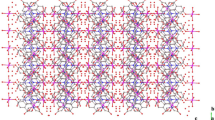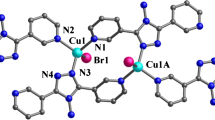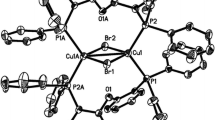Abstract
A novel copper complex [CuL(bipy)(H2O)]·H2O was synthesized by solvothermal reaction and its crystal structure was determined by single-crystal X-ray diffraction technique. (HL = 3-hydroxy-2-methylquinoline4-carboxylic acid; bipy = 2,2′-bipyrdine) The title complex (1) crystallizes in the orthorhombic system of the Pbca space group, and exists as an isolated mononuclear structure. The intermolecular hydrogen bonds and the strong π···π stacking interactions yield a three-dimensional (3-D) supramolecular network. Solid-state photoluminescence spectrum uncovers that it shows an emission in the pale blue region of the light spectrum. It has remarkable CIE (Commission Internationale de I’Éclairage) chromaticity coordinates of (0.2656, 0.3162), so it may be a very promising color lighting and display converter. Time-dependent density functional theory (TDDFT) calculation reveals that this emission is caused by to the ligand-to-ligand charge transfer (LLCT). Solid-state diffuse reflectance data shows that there is a narrow optical band gap of 1.38 eV. Therefore, it could be probably a candidate for narrow band gap semiconductors.
Graphic Abstract
A novel copper (II) complex is synthesized via solvothermal reactions, which is characteristic of an isolated structure, at the same time, it displays a wide and intense photoluminescence emission band in the pale blue region and theoretical study reveals that the photoluminescence emission is originated from the ligand-to-ligand charge transfer transition.










Similar content being viewed by others
References
Chen HJ, Lyu GY, Yue YF, Wang TW, Li DP, Shi H, Xing JN, Shao JY, Zhang R, Liu J (2019) J Mater Chem C 7:7249
Hong DF, Wang SJ, Zou Y, Zhao F, Wang JR (2019) Mol Cryst Liq Cryst 664:175
Sun C, Xu G, Jiang XM, Wang GE, Guo PY, Wang MS, Guo GC (2018) J Am Chem Soc 140:2805
Wen JW, Chen WT, Zhang ZX, Tao WJ, Liu C (2018) J Solid State Chem 263:30
Smith DK (2018) Chem Commun 54:4743
Mendes RF, Ananias D, Carlos LD, Rocha J, Almeida Paz FA (2017) Cryst Growth Des 17:5191
Wang TW, Chen HJ, Zhang R, Liu J (2018) Chin J Inorg Chem 34:1007
Wu JY, Wu B, Wang W, Chiang KS, Jen AKY, Luo JD (2018) Mater Chem Front 2:901
Wang W, Tade MO, Shao Z (2018) Mater Sci 92:33
Panda A, Forrest SR (2017) Nano Lett 17:7853
Malecki JG, Lakomska I, Maron A, Szala M, Fandzloch M, Nycz JE (2015) J Lumin 161:382
Xu WT, Zhou YF, Huang DC, Su MY, Wang K, Xiang M, Hong MC (2015) J Mater Chem C 3:2003
Ma HF, Lei Q, Wang YL, Yin SG, Liu QY (2017) Z Anorg Allg Chem 643:477
Yi ZQ, Fang XN, Cao ZY, Wei Y, Li YJ, Yi XG (2019) J Chem Res 43:58
Yi XG, Liu YZ, Fang XN, Zhou XY, Li YX (2019) Chin J Struct Chem 38:325
Dolomanov OV, Bourhis LJ, Gildea RJ, Howard JAK, Puschmann H (2009) J Appl Crystallogr 42:339
Sheldrick GM (2008) Acta Crystallogr A 64:112
Sheldrick GM (2015) Acta Crystallogr C 71:3
Becke AD (1993) J Chem Phys 98:5648
Frisch MJ, Trucks GW, Schlegel HB, Scuseria GE, Robb MA, Cheeseman JR, Scalmani G, Barone V, Petersson GA, Nakatsuji H, Li X, Caricato M, Marenich A, Bloino J, Janesko BG, Gomperts R, Mennucci B, Hratchian HP, Ortiz JV, Izmaylov AF, Sonnenberg JL, Williams-Young D, Ding F, Lipparini F, Egidi F, Goings J, Peng B, Petrone A, Henderson T, Ranasinghe D, Zakrzewski VG, Gao J, Rega N, Zheng G, Liang W, Hada M, Ehara M, Toyota K, Fukuda R, Hasegawa J, Ishida M, Nakajima T, Honda Y, Kitao O, Nakai H, Vreven T, Throssell K, Montgomery JA Jr, Peralta JE, Ogliaro F, Bearpark M, Heyd JJ, Brothers E, Kudin KN, Staroverov VN, Keith T, Kobayashi R, Normand J, Raghavachari K, Rendell A, Burant JC, Iyengar SS, Tomasi J, Cossi M, Millam JM, Klene M, Adamo C, Cammi R, Ochterski JW, Martin RL, Morokuma K, Farkas O, Foresman JB, Fox DJ (2013) Gaussion 09(Revision D.01). Gaussian, Inc., Wallingford
Lee C, Yang W, Parr RG (1989) Phys. Rev B 37:785
Li D, Li RZ, Ni Z, Qi ZY, Feng XL, Cai JW (2003) Inorg Chem Commun 6:469
Fang XN, Li J, Yi XG, Yi ZQ, Chen JY, Li YX (2019) Chin J Inorg Chem 35:930
Arora M, Jassal AK, Chawla SK, Mudsainiyan RK (2019) Mol Cryst Liq Cryst 664:142
Plessis MD, Barbour LJ (2012) Dalton Trans 41:3895
Huang FQ, Mitchell K, Ibers JA (2001) Inorg Chem 40:5123
Funding
This work was supported by the National Natural Science of Foundation of China (No. 51363009), Jiangxi Province Department of Education’s Item of Science and Technology & Higher Education and Teaching Reform (GJJ160745, JXJG-17-9-14, 20194083), Doctoral Research Startup Foundation and Natural Science Foundation Project of Jinggangshan University (JZB1905, JZ1901).
Author information
Authors and Affiliations
Corresponding author
Additional information
Publisher's Note
Springer Nature remains neutral with regard to jurisdictional claims in published maps and institutional affiliations.
Rights and permissions
About this article
Cite this article
Yi, XG., Fang, XN., Wang, YF. et al. Synthesis, Characterization, Properties, and Theoretical Calculation of an Inorganic–Organic Hybrid Mononuclear Copper(II) Complex Containing 3-Hydroxy-2-methyl-quinoline-4-carboxylate. J Chem Crystallogr 50, 348–356 (2020). https://doi.org/10.1007/s10870-019-00808-2
Received:
Accepted:
Published:
Issue Date:
DOI: https://doi.org/10.1007/s10870-019-00808-2




